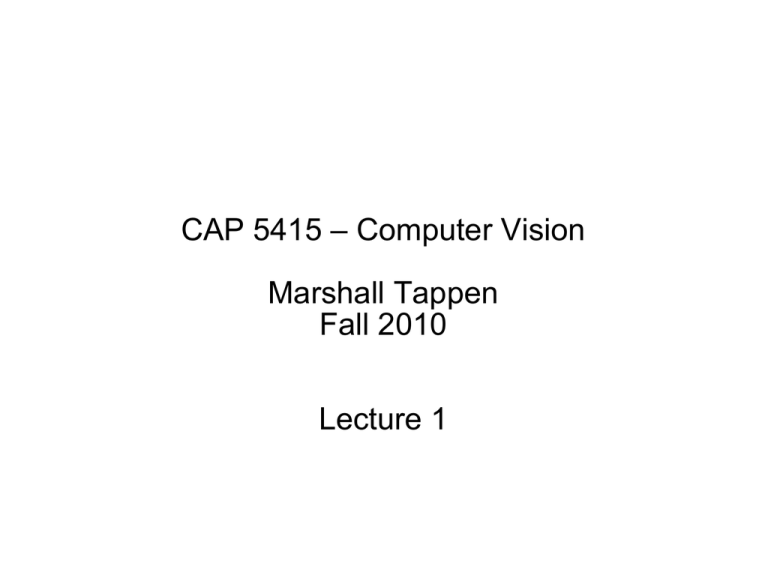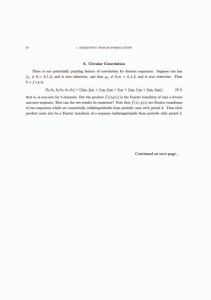Image Processing
advertisement

CAP 5415 – Computer Vision Marshall Tappen Fall 2010 Lecture 1 Welcome! About Me − − − Interested in Machine Vision and Machine Learning Happy to chat with you at almost any time − May want to e-mail me first Office Hours: Tuesday-Thursday before class Grading Problem Sets – 50% 3 Solo Problem Sets – 50% − You may not collaborate on these Doing the problems Finishing the problem sets will require access to an interpreted environment − − − NO COMPILED LANGUAGES!!!!! − − − MATLAB Octave Numerical Python No C/C++ No Java No x86 Assembler My Compiled Languages Rant MATLAB − − Environments Pro:Well-established package. You can find many tutorials on the net. Con: Not free. If your lab does not already have it, talk to me about getting access. Octave − − − Free MATLAB look-alike Pro: Should be able to handle anything you will do in this class Con: “Should be”. I'm not sure about support in Windows Environments Numerical Python − − − − − All the capabilities of MATLAB Free! Real programming language Used for lots of stuff besides numerical computing Cons: Documentation is a bit sparse and can be outdated I can get you started – I am working on a tutorial Math We will use it We will be talking about mathematical models of images and image formation This class is not about proving theorems My goal is to have you build intuitions about the models Try and visualize the computation that each equation is expressing Basic Calculus and Basic Linear Algebra should be sufficient Course Text We will use Szeliski Book – Free this year! Not required – more of a reference Course Structure This year, we will be covering pattern recognition more deeply than in previous years Machine learning is critical to modern computer vision You need to understand it well Important Foundational Topics: − − − − Image Processing Optimization Machine Learning Geometry Image Processing For now, we won't worry about the physical aspects of getting images View image as an array of continuous values Simple Modification What if we wanted to blur this image? We could take a local average − Replace each pixel with the mean of an NxN pixel neighborhood surrounding that pixel. 3x3 Neighborhood Original Averaged 5x5 Neighborhood Original Averaged 7x7 Neighborhood Original Averaged Let's represent this more generally 0 0 3 6 0 1 0 16 0 0 2 46 0 0 2 43 Let's represent this more generally 0 0 0 0 3 6 0 0 0 1 2 2 Input Image 0 16 46 43 1/9 1/9 1/9 1/9 1/9 1/9 1/9 1/9 1/9 Kernel Let's represent this more generally 0 1/9 0 1/9 0 1/9 0 3 1/9 6 1/9 0 1/9 0 0 1 2 1/9 1/9 1/9 2 0 ? ? ? ? 16 ? 1.33 ? ? 46 ? ? ? ? 43 ? ? ? ? Input Image Multiply corresponding numbers and add Let's represent this more generally 0 0 0 0 3 1/9 6 1/9 0 1/9 0 0 1 2 1/9 1/9 1/9 2 0 16 46 43 1/9 1/9 1/9 ? ? ? ? 1.33 8.22 ? ? ? ? ? ? ? ? ? Input Image Multiply corresponding numbers and add Template moves across the image Think of it as a sliding window ? This is called convolution Mathematically expressed as Resulting Image Input Image Convolution Kernel Take out a piece of paper Let’s say i= 10 and j=10 Which location in K is multiplied by I(5,5)? I(5,4) Resulting Image Input Image Convolution Kernel Notation Also denoted as R=I*K We “convolve” I with K − Not convolute! Resulting Image Input Image Convolution Kernel Sliding Template View Take the template K Flip it 9 8 7 6 5 4 3 2 1 Slide across image 1 2 3 4 5 6 7 8 9 Predict the Image Input 0 0 0 0 1 0 0 0 0 Kernel ? Output Predict the Image Input 0 0 0 0 1 0 0 0 0 Kernel Output Predict the Image Input 0 0 0 0 0 1 0 0 0 Kernel ? Output Predict the Image Input 0 0 0 0 0 1 0 0 0 Kernel Output Predict the Image Predict the Image Predict the Image Input 1 0 0 0 0 0 0 0 0 Kernel ? Output Predict the Image Input 1 0 0 0 0 0 0 0 0 Kernel Output Predict the Image Predict the Image Predict the Image Input 0 1 0 1 2 1 0 1 0 Kernel ? Output Predict the Image Input 0 1 0 1 2 1 0 1 0 Kernel Output Predict the kernel What if I wanted to compute R(i,j) = I(i+1,j) – I(i,j) at every pixel? What would the kernel be? This is one discrete approximation to the derivative What’s the problem with this derivative? [1 -1 0] − Where’s the center of the derivative? An alternative − [-1 0 1] Your Convolution filter toolbox In my experience, 90% of the filtering that you will do will be either − − Smoothing (or Blurring) High-Pass Filtering (I’ll explain this later) Most common filters: − − Smoothing: Gaussian High Pass Filtering: Derivative of Gaussian Gaussian Filter Let’s assume that a (2k+1) x (2k+ 1) filter is parameterized from –k to +k The Gaussian filter has the form And looks like Derivative of Gaussian Filter Take the derivative of the filter with respect to i: Filter looks like: Basically blur then take the derivative Effect of Changing σ Input With σ set to 1 With σ set to 3 Practical Aspects of Computing Convolutions Let's blur this flat, gray image: What should it look like? Practical Aspects of Computing Convolutions Depending on how you do the convolution in MATLAB, you could end up with 3 different images 266x266 Image 256x256 Image 246x246 Image Border Handling Lets go back to the sliding template view What if I wanted to compute an average right here? 0 3 0 0 0 6 1 16 0 0 2 46 0 0 2 43 Border Handling 1/9 1/9 1/9 1/9 1/9 0 31/9 0 0 1/9 1/9 0 61/9 1 16 0 0 2 46 0 0 2 43 Practical Aspects of Computing Convolutions Filled in borders with zeros, computed everywhere the kernel touches Called “full” in MATLAB 266x266 Image Border Handling 1/9 1/9 1/9 1/9 1/9 1/9 1/9 1/9 0 1/9 3 0 0 0 6 1 16 0 0 2 46 0 0 2 43 Practical Aspects of Computing Convolutions Fill in border with zeros, only compute at “original pixels” Called “same” in MATLAB 256x256 Image Border Handling 1/9 1/9 1/9 0 3 0 1/9 1/9 1/9 0 6 1 1/9 1/9 1/9 0 0 2 0 0 2 0 16 46 43 Practical Aspects of Computing Convolutions Only compute at places where the kernel fits in the image 246x246 Image There are other options The first two methods that I described fill missing values in by substituting zero Can fill in values with different methods − − Reflect image along border Pull values from other side Not supported in MATLAB's convolution − Eero Simoncelli has a package that supports that kind of convolution Going Non-Linear Convolution is a linear operation − What does that mean? A simple non-linear operation is the median filter − Will explore that filter in the first problem set. Practical Use of These Properties – Image Sharpening Take this image and blur it Basic Convolution Properties Can derive all of these with the definition of convolution Comes from linearity of convolution Practical Use of These Properties – Image Sharpening What do we get if we subtract the two? = This is the leftover “sharp-stuff” Let's make the image sharper We know + = Let's boost the sharp stuff a little 2× + Let's boost the sharp stuff a little 2× + = Side-by Side Now look at the computation Operations − − 1 convolution 1 subtraction over the whole image As an equation: Rewrite this This is an identity filter or unit impulse Basic Convolution Properties Can derive all of these with the definition of convolution Comes from linearity of convolution Rewrite this Now look at the computation Can pre-compute new filter Operations − 1 convolution




